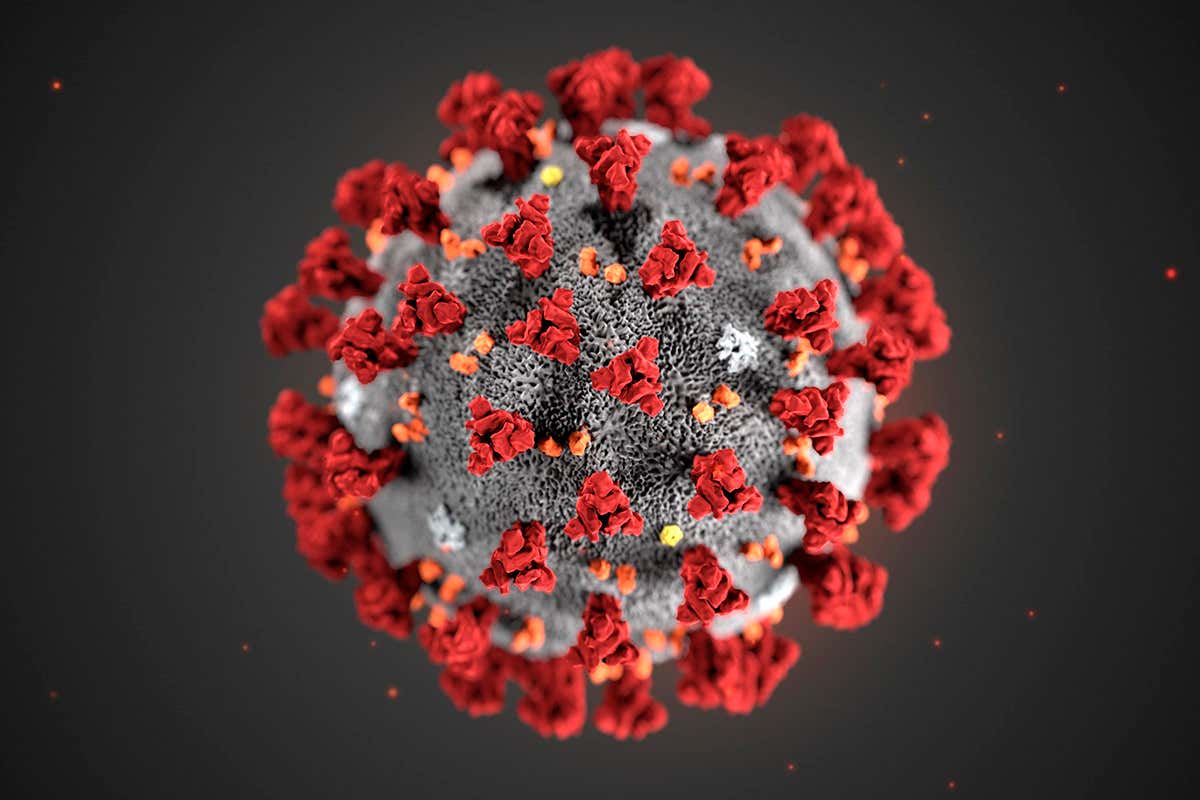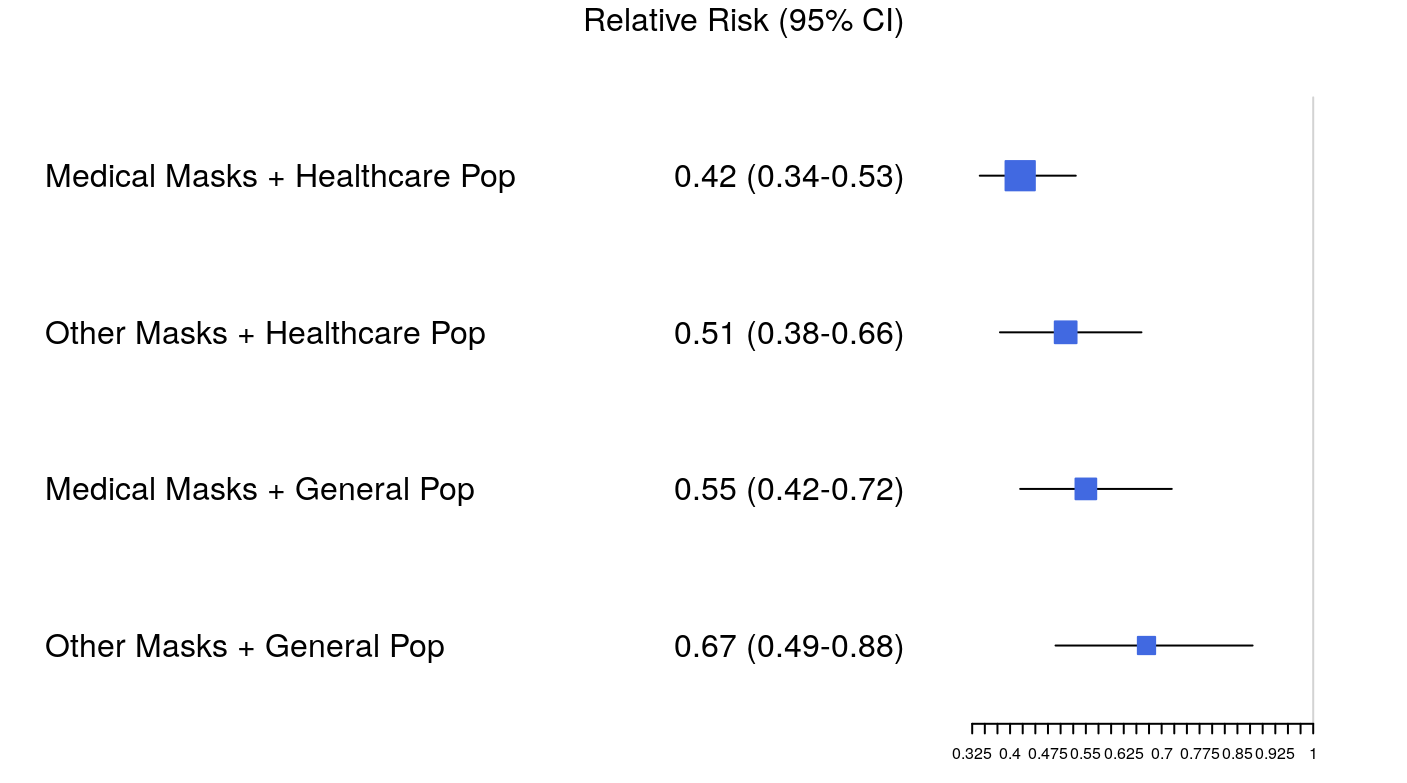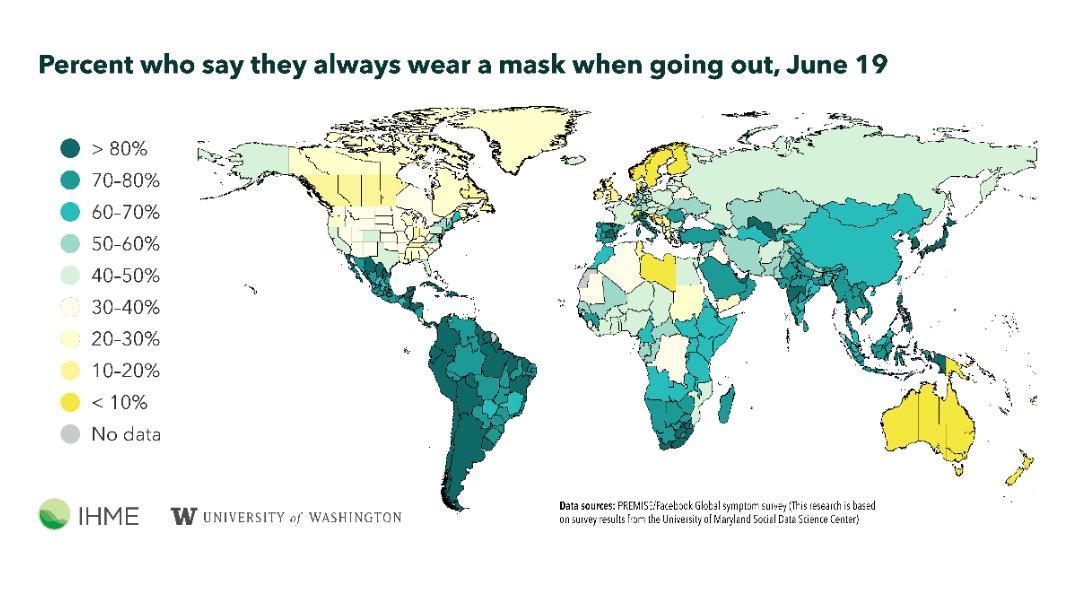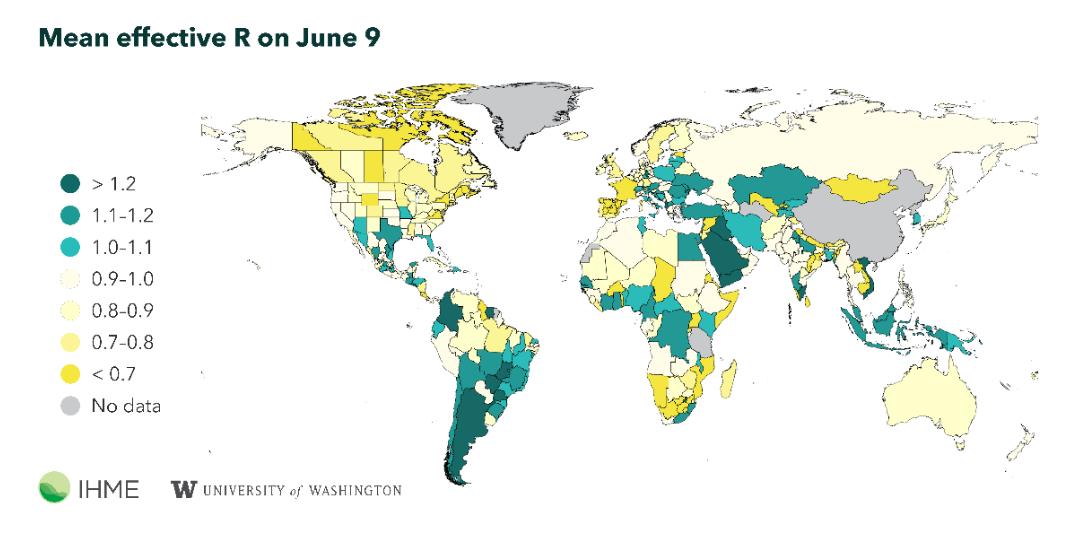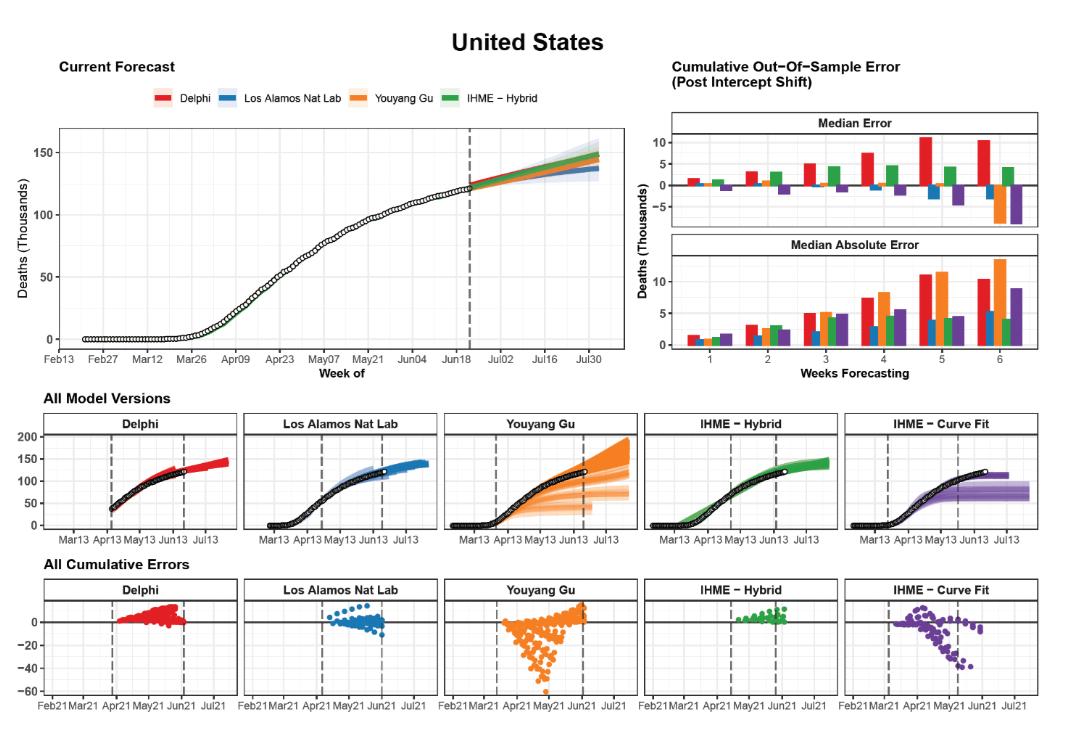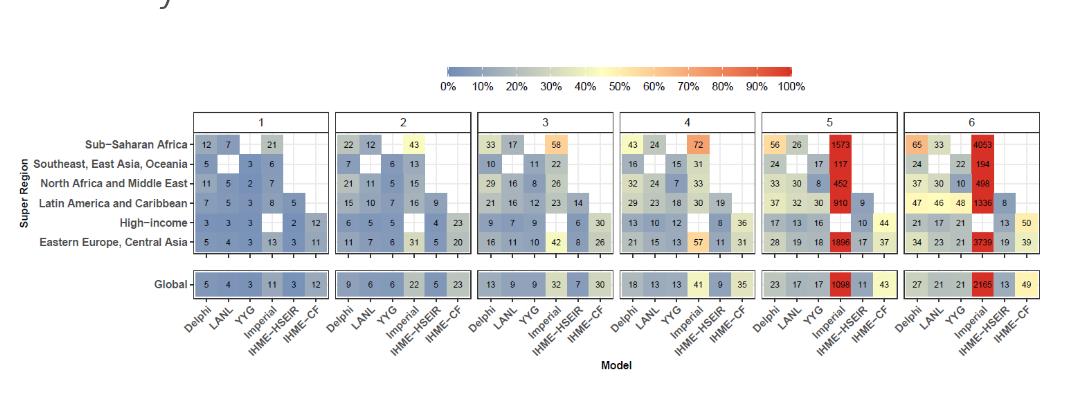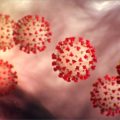GENERATING COVID-19 PROJECTIONS AND ALTERNATIVE SCENARIOS FOR ALL COUNTRIES
This Predictions was developed by the Institute for Health Metrics and Evaluation (IHME) an independent population health research center at UW Medicine, part of the University of Washington, that provides rigorous and comparable measurement of the world’s most important health problems and evaluates the strategies used to address them.
SARS-CoV-2 continues to spread globally, and for many locations, rising rates of COVID-19 infections, hospitalizations, and deaths are now occurring in the wake of eased or ended distancing policies. It is increasingly clear that COVID-19’s toll will extend beyond the summer months in the Northern Hemisphere, and current epidemics could easily worsen as the Southern Hemisphere enters its winter season.
With today’s release, we publish a first set of COVID-19 projections for nearly all countries in the world to October 1, 2020, except for countries that have experienced fewer than three deaths to date (see end of document for a complete list). In addition, today we are not releasing our projections for China, Ethiopia, Nigeria, India, Indonesia, and South Africa, but expect to do so in the next few days.
With today’s release, we also publish our first set of alternative scenarios for the trajectory of COVID-19 in the coming months. We show our current projection (what we think is most likely to happen) as well as two alternative scenarios. Here is more information on how we estimate each of the three trends shown in our visualization tool.
To construct our “Current projection” (the line that shows what we think will most likely happen), we assume that in each location the trend of easing mandates will continue at its current trajectory until the daily death rate reaches a threshold of 8 deaths per million. If the daily death rate in a location exceeds that threshold, we are assuming that mandates will be reintroduced for a six-week period. The choice of threshold (of a rate of daily deaths of 8 per million) represents the 90th percentile of the distribution of daily death rate at which locations implemented their mandates during the first months of the COVID-19 pandemic. In other words, we use the observed experience from the first phase of the pandemic to predict the likely response of governments during the second phase. We selected the 90th percentile rather than the 50th percentile to capture the increased reluctance most governments will have to re-impose mandates because of the economic effects of the first set of mandates. In locations that do not exceed the threshold of a daily death rate of 8 per million, the projection is based on our covariates and their forecasts to October 1. In locations were the daily death rate currently exceeds 8 per million, we are assuming that mandates will be introduced in a week’s time.
The first alternative scenario, referred to as “Mandates easing” in our visualization tool, shows what would happen in each location if the current pattern of easing social distancing mandates continues and new mandates are not imposed. In other words, this can be thought of as a worst-case scenario, where regardless of how high the daily death rate gets, social mandates will not be re-introduced before October 1. In locations where the number of cases is rising, this leads to very high predictions by October 1.
The second scenario, referred to as “Universal masks” in our visualization tool, shows what would happen if 95% of the population in each country always wore a mask when they were in public. This value was chosen to represent the highest observed rate of mask use in the world during the COVID-19 pandemic. In this scenario, if the daily death rate in a location exceeds 8 deaths per million, we are assuming that social mandates will be reintroduced for a six-week period, just like in our “Current prediction” model.
We have not introduced any major updates to our modeling framework or our covariates since our last release. We anticipate more data will become available on reopening plans, as well as the potential for locations to reinstate prior distancing policies or implement new ones (such as mask mandates) amid shifting COVID-19 trends. We will continue to update model inputs and parameters as new information emerges, and we will communicate these changes accordingly.
Results below can be explored online: https://covid19.healthdata.org.
A FEW KEY FINDINGS FROM JUNE 25 RELEASE
Here are some key results for the three countries with the highest cumulative deaths to date.
- Increasing mask use to rates of 95% could reduce the number of estimated deaths due to COVID-19 substantially around the world. We estimate that increasing mask use could lead to reductions in the number of deaths by greater than 50% in many locations around the world, including countries in Africa (such as the Democratic Republic of the Congo, Sudan, Kenya, and Ghana), Europe (Albania, Croatia, Poland, and Bulgaria) as well as in some US states.
- In terms of absolute numbers, increasing mask use to 95% is estimated to avert the largest number of deaths due to COVID-19 in Pakistan (25,194 deaths), Egypt (20,930 deaths), and Bangladesh (20,344 deaths).
- Predictions for the three countries with the largest death tolls due to COVID-19 to date:
- The US has had over 120,000 deaths so far. By October 1, 2020, cumulative COVID-19 deaths could reach 179,106 deaths (with an estimated range of 159,497 to 213,715). In terms of the mean projection, this represents approximately 60,000 additional cumulative COVID-19 deaths between today and October 1, 2020. That number drops to 146,047 (with a range of 140,849 to 153,438) if at least 95% of people wear masks in public. In other words, if 95% of the US population always wore masks in public, more than half the deaths that are predicted between now and October 1 would be avoided.
- In Brazil, the cumulative death number has reached 54,289 (with an estimated range of 53,808 to 54,816) and is predicted to increase to 166,362 (with an estimated range of 135,538 to 208,079) by October 1. If use of masks in public were to exceed 95%, this number would reduce to 147,431 (with an estimated range of 121,048 to 186,281). The reduction in Brazil is relatively smaller in the scenario of universal masks because mask use in Brazil is already at high levels (over 75% self-reported use). The “Easing mandates” scenario shows that if Brazil were to continue with mandate easing and not re-impose mandates when daily deaths exceed the threshold of 8 deaths per million, the total death count by October 1 could reach 340,476 (with an estimated range of 232,929 to 479,668). This estimate of a worst-case scenario highlights the importance of re-imposing mandates when the daily death rate increases.
- The UK has seen 42,976 deaths as of June 25 (with an estimated range of 42,904 to 43,054). Our predictions suggest that an additional 4,948 deaths will occur between now and October 1. However, if use of masks were to reach 95% or higher, 2,528 of these deaths would be avoided.
WHY MASKS? HOW EFFECTIVE ARE MASKS?
Building on recently published meta-analyses and incorporating 41 papers, IHME researchers performed a meta-analysis of peer-reviewed scientific studies and medRxiv pre-prints in an assessment of mask effectiveness for preventing respiratory viral infections. The studies were extracted from a medRxiv publication by Liang, M., Gao, L., Cheng, C., Zhou, Q., Uy, J.P., Heiner, K., & Sun, C. (May 5, 2020) titled “Efficacy of face mask in preventing respiratory virus transmission: a systematic review and meta-analysis.” In addition, we considered all articles from a second meta-analysis by Chu, D.K., Akl, E.A., Duda, S. et. al., published June 1, 2020, in The Lancet, titled “Physical distancing, face masks, and eye protection to prevent person-to-person transmission of SARS-CoV-2 and COVID-19: a systematic review and meta-analysis.” Lastly, we added one supplementary publication by Wang, Y., Tian, H., Zhang, L. et. al., published May 11, 2020, in BMJ Global Health, titled “Reduction of secondary transmission of SARS-CoV-2 in households by face mask use, disinfection and social distancing: a cohort study in Beijing, China.”
We extracted all relevant outcomes per study. Additionally, we extracted and included additional covariates and explored various model specifications.
|
Category |
Covariates |
|
Type of population using mask |
General population versus health care population |
|
Country of study |
Asian countries versus non-Asian countries |
|
Type of mask |
Paper/cloth or nondescript versus medical masks and N95 masks |
|
Type of control group |
No use versus infrequent use |
|
Type of disease |
SARS-CoV 1 or 2 versus H1N1/influenza/other respiratory pathogens |
|
Type of diagnosis |
Clinical versus laboratory |
We used IHME’s customized meta-regression tool (“meta-regression—Bayesian, regularized, trimmed,” or MR-BRT) to perform a meta-analysis that takes into account the various characteristics of each study (shown in the table above) and captures between-study heterogeneity. We also explored various sensitivity analyses to verify the robustness of the modeled estimates and found that the estimate of the effectiveness of mask use did not change significantly when we explored four alternative analyses, including changing the continuity correction assumption, using odds ratio (OR) versus relative risk (RR) from published studies, using a fixed effects versus a mixed effects model, and including studies without covariate information.
Our analysis of all respiratory infections and mask effectiveness suggests a reduction in infection for mask-wearers by at least one-third compared to control groups. This work supports the growing scientific consensus that cloth masks, whether homemade or commercial, can reduce respiratory virus infections by 33% and slow community spread of COVID-19.
How many people are wearing masks around the world?
Mask-use data analyzed by IHME come from two sources. For the US, IHME analyzed survey data provided by Premise, a crowd-sourcing data collection company. Covering all 50 states and Washington, DC, Premise data range from the week of April 21, 2020, to the present, with a new data file provided to IHME on a weekly basis. For all other countries, we use survey data collected by the Facebook Global symptom survey (this research is based on survey results from University of Maryland Social Data Science Center). Data collection started on April 23, 2020, and continues to the present. IHME receives the data with a two- to three-day lag. Data are collected in 101 countries and are available for the states/provinces within the countries where we provide model estimates at the subnational level.
The map below shows the proportion of people reporting always wearing a mask when outside their home on June 19, which represents the date of the most recent data that contributed to our model predictions published today.
Note: this figure was updated 7/7.
Globally, mask use has increased dramatically since March. However, reported mask use remains relatively low in North America and Northern Europe. In North America, rates are relatively low in both the US and Canada. Across US states, we see a range of 15% in Tennessee to 62% in Massachusetts. Mask use rates in Northern Europe are markedly lower. Only 11.5% of people in the UK report wearing a mask. Lowest reported use is found in Nordic countries, with only 1% of the population in Denmark, Norway, and Sweden answering in the affirmative. Low mask use rates are also observed in Australia and New Zealand, a phenomenon likely explained by near-zero case rates in both countries. Reported mask use is high across Latin America, where Chile has the highest reported use (93%), followed by Guatemala (92%), Peru (90%), and Bolivia (90%). In South and Southeast Asia, high rates of mask use are reported. In Africa, there is wider variation across countries, with rates as low as 21% in Sudan and as high as 85% in Gauteng province in South Africa.
Given the effectiveness of masks to reduce transmission, widespread use of masks has the potential to change the course of the pandemic and, in many locations around the world, prevent a second wave from happening. So, please, wear a mask. Always wear a mask.
WHERE ARE THE NUMBER OF INFECTIONS INCREASING RIGHT NOW?
The map below shows the mean value (across the 1,000 regressions that we run in our SEIR model) of effective reproductive number, R, on June 9. Infections on June 9 roughly correspond to cases of COVID-19 on June 20 given the average duration of 11 days between infection and being reported as a case. Where this value is greater than 1, it means that every person infected with COVID-19 will produce more than one additional infected person. To successfully eliminate a disease from a population, R needs to be less than 1.
The map shows that on June 9 in many parts of the world, R was lower than 1, including many parts of North America, Europe, Africa, India, Australia, and New Zealand. Locations that are showing effective R values greater than 1, which means that the number of cases of COVID-19 in the population is growing, include several states in India, the US, Mexico, and Brazil, as well as many countries in the Southern Hemisphere, such as Argentina, Chile, and Indonesia. Several countries in the Middle East, including Egypt, Saudi Arabia, Iraq, and Yemen, as well as Turkey and Iran, also had R values greater than 1 as recently as two weeks ago.
Note: this figure was updated 7/7.
HOW WELL IS OUR MODEL PERFORMING? INTRODUCING A GLOBAL FRAMEWORK FOR COVID-19 MORTALITY FORECAST COMPARISONS
Forecasting models have provided critical information about the course of the COVID-19 pandemic. In attempting to predict both the timing of peak deaths and the total magnitude of mortality, these models have played an influential role in driving the responses of policymakers and health systems alike. Although a number of groups have provided comparisons of out-of-sample predictive validity – checking how well past versions of forecasting models predict subsequently observed trends – these have been predominantly focused on the United States. Similar systematic comparisons have not been undertaken globally, despite the growing number of countries being affected by COVID-19. We therefore undertook a review of each model, its assumptions, and its out-of-sample predictive performance. This is of particular importance as forecasting models increasingly seek to leverage observed trends in places with established or concluded epidemics, such as the United States or Europe, to predict future trends for the emerging epidemics in other locations, such as Brazil and India, as well as countries in Africa.
As data and models are updated regularly, a publicly available, transparent, and reproducible framework is required to evaluate them in an ongoing manner. We are excited to share preliminary work on the creation of such a framework as a public good to aid researchers and policymakers in critically and systematically assessing model performance. It is our hope that this spurs conversation and cooperation among researchers, which might lead to more accurate predictions and ultimately aid in the collective response to COVID-19.
Creation of the framework
To create this framework, we have reviewed 93 published and unpublished COVID-19 forecasting models and have comprehensively evaluated six models for which publicly available, multinational, and date-versioned mortality estimates could be downloaded (see table below). These included those models by DELPHI-MIT (Delphi), Youyang Gu (YYG), the Los Alamos National Laboratory (LANL), Imperial College London (Imperial), and two models produced here at IHME, the Curvefit model (IHME-CF) that was used between March 26 and end of April, and the hybrid epidemiological compartment model (IHME-HSEIR), which we have used since early May. Collectively, these models cover 164 countries, as well as the 50 US states and Washington, DC, and accounted for >99% of all reported COVID-19 deaths on June 23, 2020.
|
Model |
Data Access |
Model Type |
Geographies |
Range |
|
|
1 |
IHME – CurveFit |
Statistical Curve fit |
73 Countries* |
August 4 |
|
|
2 |
IHME – Hybrid SEIR |
Hybrid SEIR + Curve fit |
73 Countries* |
October 1 |
|
|
3 |
Youyang Gu |
SEIR |
76 Countries* |
October 1 |
|
|
4 |
MIT – DELPHI |
SEIR |
151 Countries* |
6 weeks |
|
|
5 |
Imperial–LMIC |
SEIR |
109 Countries |
12 weeks |
|
|
6 |
LANL–Growthrate |
Dynamic Growth |
121 Countries* |
6 weeks |
These models differ across a number of dimensions, including which sources of input data they draw upon, how often they are updated, how far they extrapolate in time, and for which locations, as well as the specific outcome metrics predicted. Differences in each of these areas must be taken into account to provide a fair and relevant comparison between the models.
Reference data comparison: We chose to use mortality data collected by the Johns Hopkins University Coronavirus Resource Center (JHU), used widely across models as input data, as the reference data against which forecasts were compared. These data have been similarly used in validation exercises for US-based predictions. It is worth noting that IHME does use JHU data for many of our locations, but not all. We assess the quality of JHU data, and for locations where we find a more reliable or valid source of information, we use that alternative source.
Frequency of publication: Most forecasting models are updated regularly, but at different intervals, and on different days. Given that specific days of the week have been associated with a greater number of reported deaths on average, previous model comparison efforts in the United States – such as those collected by the CDC – have required modelers to produce estimates using input data cutoffs from a specific day of the week. For the sake of including all publicly available modeled estimates, we took an inclusive approach, considering each iteration of each model, and focusing on errors in cumulative and weekly mortality, which are less sensitive to day-to-day fluctuations in reported mortality magnitude.
Locations and forecast duration: Each model produces estimates for a different set of national and subnational locations, and extrapolates a variable amount of time from the present. Each was also first released on a different date, and so reflects a different overall window of the COVID-19 pandemic. We included estimates from all possible locations and time periods, although we stratified by region and weeks of extrapolation, and masked summary error statistics reflecting small numbers of locations or time points.
Quantities compared: Each model includes different estimated quantities, including daily and cumulative mortality, number of observed cases, number of true underlying cases, and various dimensions of hospital resource utilization. We focus on mortality, as it was the only universally reported outcome.
Cumulative mortality forecasts and prediction errors by model – example for United States
The most recent version of each model is shown on the top left. The middle row shows all iterations of each model as separate lines, with the intensity of color indicating model date (darker models are more recent). The vertical dashed lines indicate the first and last model release date for each model. The bottom row shows all errors calculated at weekly intervals from one to six weeks. The top right panel summarizes all observed errors, using median error and median absolute error, by weeks of forecasting. Errors incorporate an intercept shift to account for differences in each model’s input data.
Below are the same graphs for the UK and Brazil, the two countries with the highest numbers of total deaths to date after the US. Similar graphs for all other locations will be available in a forthcoming preprint manuscript.
Assessing the magnitude of mortality
The evaluation framework we developed for evaluating the magnitude of mortality is shown for three example countries – the United States, the United Kingdom, and Brazil. We retrospectively calculated the error in cumulative mortality compared to subsequently observed trends by number of weeks of model extrapolation up to six weeks. We used the median absolute percent error (MAPE) as a measure of accuracy.
Predictive validity of cumulative mortality – median absolute percent error
Median absolute percent error values were calculated across all observed errors at weekly intervals for each model. Results are shown separately by super-regional grouping used in the Global Burden of Disease study (top) as well as globally (bottom). Results are also shown separately by weeks of forecasting, seen at the top of each box. Values that represent fewer than five locations for a given super-region grouping are not shown.
As we would expect, the magnitude of errors increased with longer durations of extrapolation. At two weeks, the best-performing model was the IHME-HSEIR model, with a MAPE of 4.5%, followed by YYG (5.7%) and LANL (6.1%). At six weeks, the IHME-HSEIR model had a MAPE for cumulative deaths of 12.8%, followed by LANL (20.6%), YYG (21.6%), and Delphi (27.5%). Comparing between geographies, errors in cumulative mortality predictions were consistently highest in sub-Saharan Africa. In contrast, MAPE values were lowest among high-income countries, at 5.9% and 22.6% at two and six weeks, respectively. These systematic regional differences reflect both differences in underlying data availability and also a different level of prediction difficulty in earlier versus later stages of the epidemic.
Sharing the framework
Transparency and reproducibility of this framework will be key for researchers and policymakers to systematically compare and improve on existing predictions. Stay tuned for a preprint manuscript that will be available soon and will offer additional comparisons, such as how each of these models has performed in predicting the timing of peak mortality in addition to the magnitude of mortality. We will also release a publicly available codebase that will allow other researchers to recreate, update, and adapt upon our framework.
DATA UPDATES SINCE OUR LAST RELEASE ON JUNE 8, 2020
Data and locations
- Reported data on COVID-19 deaths, cases, hospitalization, testing, and mobility, as well as available information on social distancing policies, have been added through at least June 20.
- We have provided estimates and alternative scenarios for all countries in the world, except the following: American Samoa, Bermuda, Bhutan, Burundi, Cambodia, Cook Islands, Dominica, Ethiopia, Fiji, Greenland, Grenada, India, Indonesia, Kiribati, Laos, Lesotho, Marshall Islands, Micronesia, Mongolia, Namibia, Nauru, Nigeria, Niue, North Korea, North Mariana Islands, Palau, Saint Kitts and Nevis, Saint Vincent and the Grenadines, Samoa, Saint Lucia, Seychelles, Solomon Islands, South Africa, Tanzania, Timor-Leste, Tokelau, Tonga, Turkmenistan, Tuvalu, and Vanuatu. Estimates for Indonesia and Nigeria will be released tomorrow, and those for Ethiopia, India, and South Africa in the next few days.
Covariate updates
- Mobility predictions and reopening of educational facilities. As mentioned above, a key aspect of making COVID-19 projections to October 2020 involves capturing potential effects of reopening educational facilities for the 2020–2021 academic year, particularly in the Northern Hemisphere. Start dates for schools are extremely variable: they differ by education level (primary, secondary, and higher education), school type (public versus non-public), and even by school district. For our current model, we have decided to use August 15 to reflect a time when many schools might otherwise resume instruction, or at least many educational facilities may be actively preparing for the new school year and thus some combination of staff and students may be interacting with each other again. At this date, we assume locations that have not already eased or ended school closures will do so. This distancing policy status update is then propagated through mobility predictions and thus informs the transmission dynamics component of our broader modeling platform. The May 4 estimation update provides additional detail on this process to date.
- In addition to mobility, covariates currently in our model include COVID-19 testing rates, mask use, pneumonia mortality rate, air pollution, altitude (proportion of the population that live in locations that are under 100 m above sea level), smoking prevalence, and population density.
WHAT’S IN THE DEVELOPMENT PIPELINE FOR IHME COVID-19 PREDICTIONS
Before we introduce new model components or improvements to our current analytical platform for predictions, IHME’s COVID-19 development team members test these additions or changes.
Based on currently available data and model testing progress, our immediate- and medium-term priorities are as follows:
- Additional scenarios for COVID-19 projections for the world. We are preparing the machinery to be able to estimate the trends for additional scenarios, including introducing intermittent mandates in the future. We are receiving many requests for additional scenarios from policymakers at the national and local level in many countries, and we hope to be able to produce the scenarios that are most relevant to them and that will provide useful input in their decision-making process in the near future.
- Additional potential epidemic drivers. In addition to the covariates now incorporated into our models, we are exploring the inclusion of indicators such as human contact rates, use of public transit, household size, and humidity, among others.
- Additional analysis for the US. We are hoping to soon be able to release estimates and predictions by race/ethnicity and by sex in the US. We are also working on making predictions at the county level in the US.
A NOTE OF THANKS
We would like to extend a special thanks to the Pan American Health Organization (PAHO) for key data sources; our partners and collaborators in Argentina, Brazil, Bolivia, Chile, Colombia, Cuba, the Dominican Republic, Ecuador, Egypt, Honduras, Israel, Japan, Malaysia, Mexico, Moldova, Panama, Peru, the Philippines, Russia, Serbia, South Korea, Turkey, and Ukraine for their support and expert advice; and to the tireless data collection and collation efforts of individuals and institutions throughout the world.
In addition, we wish to express our gratitude for efforts to collect social distancing policy information in Latin America to University of Miami Institute for Advanced Study of the Americas (Felicia Knaul, Michael Touchton), with data published here: http://observcovid.miami.edu/; Fundación Mexicana para la Salud (Héctor Arreola-Ornelas) with support from the GDS Services International: Tómatelo a Pecho A.C.; and Centro de Investigaciones en Ciencias de la Salud, Universidad Anáhuac (Héctor Arreola-Ornelas); Lab on Research, Ethics, Aging and Community-Health at Tufts University (REACH Lab) and the University of Miami Institute for Advanced Study of the Americas (Thalia Porteny).
Further, IHME is grateful to the Microsoft AI for Health program for their support in hosting our COVID-19 data visualizations on the Azure Cloud. We would like to also extend a warm thank you to the many others who have made our COVID-19 estimation efforts possible.

